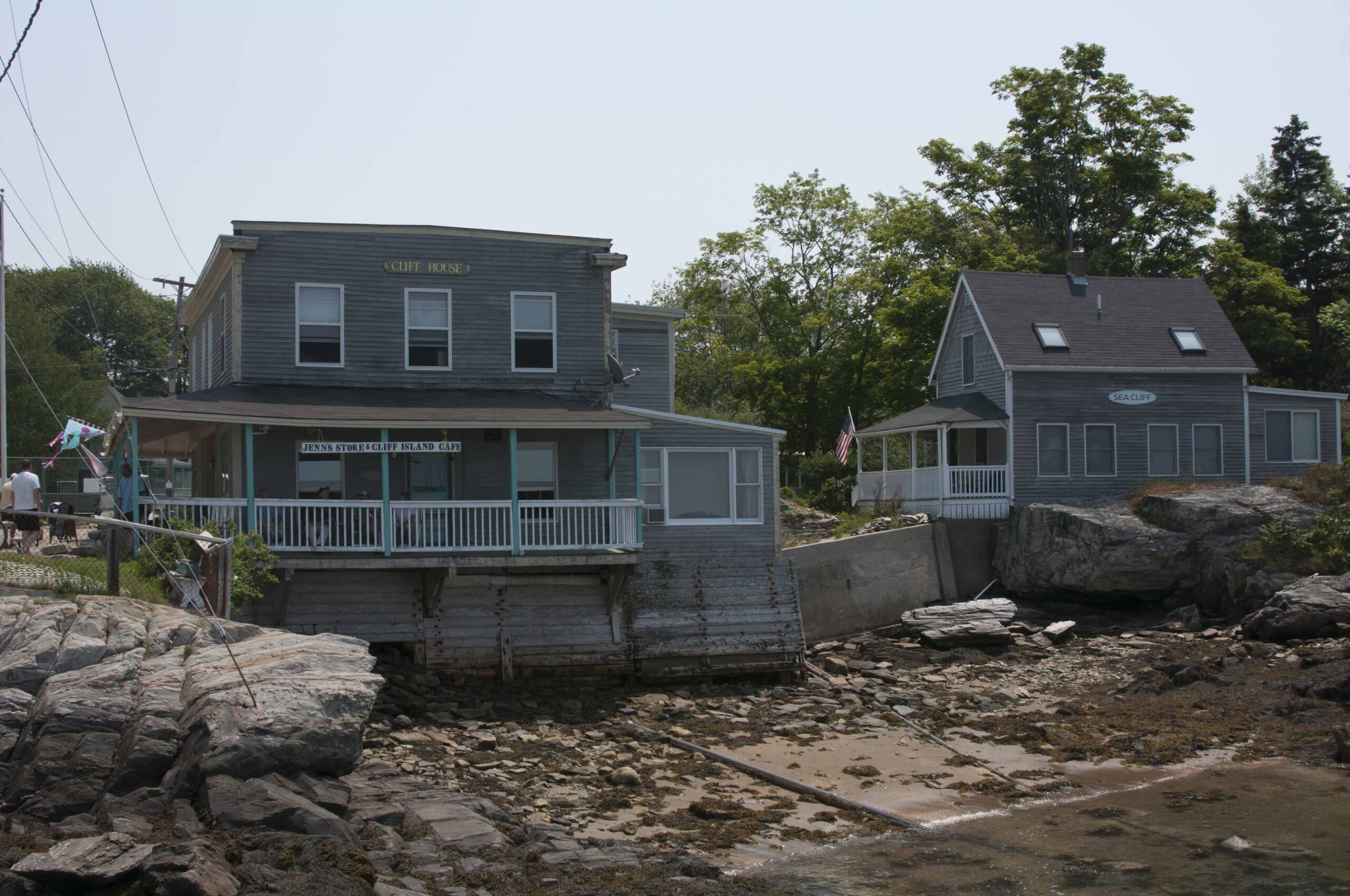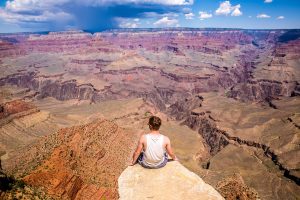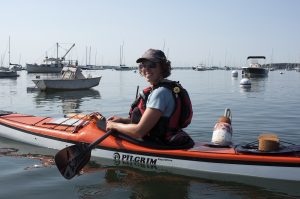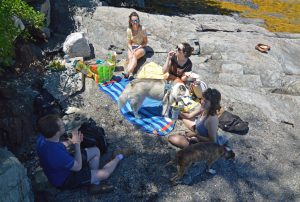Maybe we were wrong to do it like this from the start. Maybe trying to codify, or even observe, what it is that makes island life unique just leads to its being transformed and ultimately diminished.
“Hm. I’m not sure,” Lyn McElwee responds after a thoughtful pause. “I don’t know. Maybe just let them experience it through your eyes.”
Lyn is not the type to be short on answers. She is one of the part-time “post mistresses” on Bustins Island, our setting for this story. She is, like many of the 200 odd summer residents here, an engaged member of the island community. She’s designed the island’s newest rain garden. She holds the keys to the historical society. She can tell you all about Archie Ross, the colorful ship captain who, for more than 50 years, ran the only ferry between Bustins and Freeport proper–of course, that was before he retired and the island association decided to invest in their own co-operative ferry business.
Lyn’s “cottage” as islanders are heard saying–though, ‘cottage’ doesn’t really express the stylishness or richness of the island residences, Lyn’s included–nevertheless, Lyn’s “cottage” was handed down by a great uncle. It’s a functioning testament to intergenerational collaboration, the work of many summers and many pairs of hands. Incidentally, it was also the first residence on the island to have solar panels installed, 16 years ago.

This is all to say that Lyn is an excellent docent and a fount of local knowledge. It would be wrong and simplistic to say that Lyn typifies the Bustins islander or, for that matter, any islander. Part of what fuels the Maine “islander” narrative, ironically, is the fact that each island community is unique and that, generally speaking, island residents themselves can be stubbornly individualistic.
But Lyn’s roots run deep on this quiet, densely forested isle fifteen minutes southeast of Harraseeket’s mouth, and in her I’ve found a sort of spokesperson for the Bustins community, and fate having been the only force to introduce us on this sunny August day, I pose her the conundrum that has been clouding my thoughts since five minutes into the ferry ride.
I say it tacitly. “Some islands, they all but advertise their openness for visitors and tourists. I’m thinking of Peaks,” I say. “Some islands in Casco Bay, you basically need an invitation to set foot on them. But with Bustins–“
“We’re somewhere in the middle,” Lyn interjects.
I nod and continue: “I’ve spoken to other people about this today. Everyone wants to show off this place–“
“Oh yes,” she confirms.
“–but at the same time, no one wants me to encourage a lot of other visitors.”
“We love to share our island, we love guests…” she begins.
But I can see the dilemma on Lyn’s face. The same one I’ve struggled to parse and explain for nearly 10 years. I can see that this dilemma is not new. And I know, from my own experience with these communities, that it is in fact woven into the very fabric of island life.
Islands
I need to zoom out and fill in the periphery. In 2010 I was sent to spend the day on Peaks Island, a well-known daytrip destination and the most populous of the Casco Bay Islands, to write a “go-and-do” for the Sun Journal. Even those unfamiliar with journo slang should be able to understand that “go-and-do” stories are meant to encourage readers to go out and do something, in this case it was to go and spend a day on Peaks Island.
That story was followed in 2012 with a daytrip (which almost turned into an overnight stay after I missed the last ferry home) on Chebeague Island, then Long Island the following year, next Great Diamond, and then Cliff, and next various stops along the Maine Island Trail, and then Cousins, and finally Mackworth Island just last year. Over 10 years this summer series has explored the environments and communities on nearly as many Casco Bay islands.
To be sure, these pieces were never intended to be hard-hitting. They aren’t gritty exposés of island life and island politics. On the contrary, they were meant to be easy-to-digest previews in advance of a reader’s own island trip. And I like to think that throughout these nine stories, I’ve illustrated these charming and dynamic communities with color and levity and a dose of humanity.
But in my untrained and informal fashion, it’s been impossible not to relay the sentiment of islanders and the communities they represent, even when those sentiments have been antithetical to the very suggestions I’ve made to readers.
I remember six years ago speaking to Scott Wood, owner of Boathouse Beverage and a lifelong resident of Casco Bay’s Long Island. “When I was young, you didn’t see somebody you didn’t know,” he said, but “we are moving toward Peaks, slowly.” His voice was languid and resigned. Contained in that short sentence was the cyclical history of many Maine islands, a discomforting trajectory, and the conundrum that only now I can fully articulate: The islands of Casco Bay are beautiful and special places that give life to rich communities, and those communities–out of a sense of pride and a generosity of spirit, I suppose–want to share that beauty. But to share too much diminishes not only the environment but the very sense of community that makes these places so special.
It’s the observer effect, the theory that the mere observation of a phenomenon inevitably changes that phenomenon. Maybe we were wrong to do it like this from the start. Maybe trying to codify, or even observe, what it is that makes island life unique just leads to its being transformed and ultimately diminished.
Hospitality
To be sure, there is no lack of hospitality on Bustins Island. In fact, I would struggle to remember an island assignment with more warm welcomes. On the ferry ride over, the photographer and I are obvious outsiders–the Lilly B is staffed mainly by islanders and the passengers are almost unanimously island residents. But within literal seconds of stepping aboard, residents are striking up conversations, asking us about our plans and what brings us to Bustins.
After explaining the assignment, we’re quickly introduced to Chris Martens.
“I’ve been on the island since I was two weeks old,” she tells me. “I grew up in Massachusetts, I now live in Maine. I’m a commercial fisherman actually,” out of Ogunquit.
Bustins is a “summer island,” she says. The island is off the grid and no one stays over the winter, though some residents make it till December before “pulling the boat out.”
Martens winters in Northport, but she is equally a resident of the Bustins community, a village corporation within the municipality of Freeport.
The annual meeting has just taken place this morning, Martens says, and there’s a dance for the island kids coming up. “It’s just a kids’ one tonight,” she says. “It’s old-fashioned, you know, bingo and hokey pokey… Everybody loves the square dance for the kids and it’s a memory that all these people that are older have… That’s why my granddaughters are here tonight.”
One of Chris’s granddaughters, Madelaine Martens, is working on the ferry today. “I do all the ticket sales, tying up at the dock, just whatever,” Madelaine explains.
Madelaine is pensive when asked to describe the island. “It’s very unique,” she says, slowly. “I don’t know. I’ve grown up with all my cousins out there, third cousins, fourth cousins. It’s pretty cool to get to know them–“
“Often their great grandparents knew each other,” Chris adds.
“You see the same people,” Madelaine continues. “You leave and you come back and it’s like nothing’s changed. You pick up right where you left off.”
From a chance meeting on the ferry, Chris becomes our point of contact and our first tour guide. She is a former chair of the Bustins planning board. But, then, it seems everyone is involved in island government.
Chris prompts us to visit the historical society. “If you need help,” she says, “I’ll find someone who can get you a key.” She invites us to her cottage and, as her grandchildren play on the floor, she searches for a book, History of Bustins Island, Casco Bay, 1660 – 1960, by George Richardson. Standing on the porch, she points to a grey house just a bit farther along the shore path. That was Richardson’s cottage, she explains.
“I know I had a copy here,” she says. But it’s disappeared. Instead, she presents us with a map of the island, color-coded by the age of the cottages, and she gives us instructions to our next destination, a rocky bit of coastline where we can eat our lunch.
The island is small and easily walkable with a loop road winding around its edge. We’ve been told to look out for the tennis courts and the golf course, “amenities for island residents,” Chris calls them. We find them quickly–they’re hard to miss. In the afternoon heat, the photographer and I take advantage of the high tide and cool off in a little, rocky cove. Coming back down the loop road, we run into a group of residents working on a rain garden, meant to hold in moisture, stop rainwater runoff, and feed bees and butterflies.
“We worked on this with the Cumberland County Soil and Water Conservation District,” says Charlotte Kahn, who works on the planning board and the landscaping committee. “We’re one of seven or eight fire-wise communities in the state of Maine,” she says.
Charlotte explains why the interior of the island is so lush and undeveloped. It’s part of the “resource protection area,” donated parcels that are now off-limits to building. It’s just one of the ways that the island community protects its freshwater aquifer, guards against runoff and erosion, and mitigates fire danger.
This is also where we meet Lyn, who holds the keys to the historical society.
“Our biggest fear is fires, because we have no water under pressure on the island,” Lyn tells us, standing in front of the new rain garden. “And all the cottages are about 100-plus years old, so they’re all tinderboxes.”
It’s hard to relay the warmth with which we’ve been received. On the shore road, passing a group we’d first encountered on the ferry, we’re peppered with questions.
“How’s it been so far?”
“Did you find the beach?”
“Did you go swimming?”
No one is shy. Everyone has a story to share, a fact about the island, a point of pride. There’s a palpable desire to share this place and the things that make it special.
We meet Janice Boyko on the ferry landing. She and her husband, Jim, are about to meet up with some friends to take a trip on their boat into Casco Bay, now roiling with small breakers.
“Do you two need to use a bathroom?” she asks us. “Do you just want a place to sit down? Come on, come with us over to the cottage.”
Janice walks us down the shore path to her cottage. Inside, Jim offers us seltzer water and then, when we decline, he points to the fridge. “Help yourself,” he says. Jim and Janice will leave in a moment to head into the choppy waters of the bay, but they tell us–a reporter and photographer they have known for 10 minutes–to make ourselves at home, feel free to finish our picnic at their cottage, and use the bathroom if we need.
Finishing the circle
Our journey around Bustins Island is very literally finished with Lyn, our final tour guide. We walk with her down the last bit of shore path yet to be explored, to her cottage, handed down by her great uncle, renovated and re-renovated–they’ve just replaced the solar panels with a new array and they’re getting four times the power output, she tells us.
Again we are invited inside and again we receive a warm welcome, this time from Lyn’s dog. Outside, she tells us that there was once a resort on the island and a steam-powered ferry that brought droves of day-trippers and folks from away.
Lyn might be called an island historian. She takes us to the post office (it’s actually a contract postal unit, not an official post office, she explains), she shows us the lending library and the “real” library (though that’s closed today), she points out candy counter (the “favorite thing for the island kids”).
We go next door, to the historical society. Lyn shows us–and even lets me play–the piano used by Cole Porter back when he was a camper at the island’s all-boys summer camp, a summer camp run by Arctic explorer Admiral Donald MacMillan.
Room by room, Lyn presents the large collection of the historical society. Old appliances, stoves, and décor from different cottages and bygone eras, the checkout counter and metal advertisements from when the historical society was the island store, the models of past island ferries (Archie Ross’s is there, as well as the Lilly B), and the quilt on the far wall, made with patches from dozens of island residents.
I am getting close to posing my question to Lyn. All day we have been met with truly exceptional warmth and all day, with the same half-joking tone, we’ve heard nearly the same caveat: “Now, don’t tell anyone about this.”
Here, inside the historical society, I realize that I’ve been primed to understand this dilemma. This year we actually struggled to find a Casco Bay island that we haven’t visited, one with a unique sense of community. After a decade, we’re simply running out of options. We had initially tried Cushing, to the south of Portland, but the community there–rightly and naturally–values their peace and quiet. To get access to that privately owned island, one needs to be invited.
Maybe an invitation is appropriate for Bustins as well and, yet, here we are, welcomed into homes, offered to partake in the island amenities, given tours and unbridled hospitality. There is a limit, I’m sure, though no one has said it, and I imagine it is somewhere around the point at which the character of this place itself starts to shift.
I’ll ask Lyn about this. I’ll get her very practical response–“Maybe just let them experience it through your eyes.” I’ll do that later. For now, the photographer and I admire the quilt and the historical society’s carefully curated pieces.
“A lot of people have spent a lot of time pulling this together,” Lyn says. She’s gesturing around the main exhibit room, but her arms cast a shadow as wide as the island itself.









Comments are closed.